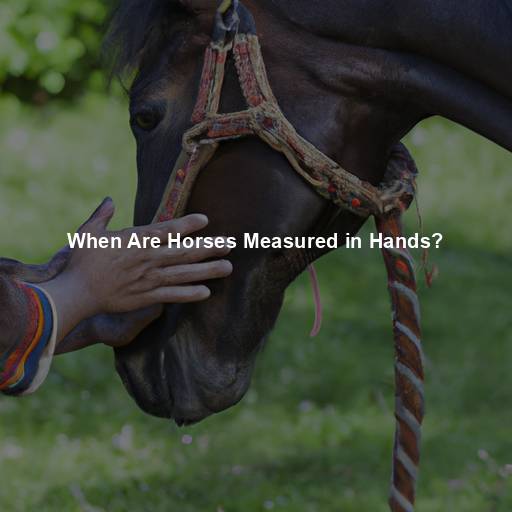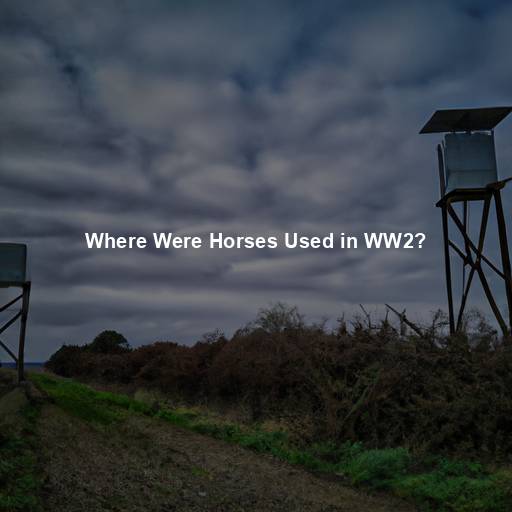When Are Horses Measured in Hands?
Last Updated on July 31, 2023 by Evan
Contents
- 1 Understanding the Measurement System for Horses
- 2 Embracing the Beauty of Horse Measurement
- 3 Measuring a Horse in Hands
- 4 Exceptions to the Hand Measurement System
- 5 The Cultural Significance of Hands
- 6 Interpreting Horse Height Measurements
- 7 Horse Height Misconceptions
- 8 Celebrating Horses of All Heights
- 9 FAQs: When are horses measured in hands?
- 9.1 What does it mean to measure a horse in hands?
- 9.2 When do horses typically get measured in hands?
- 9.3 Can all horses be measured in hands?
- 9.4 How is a horse measured in hands?
- 9.5 Why is it important to measure a horse in hands?
- 9.6 Are there specific conversion charts to measure horse height in hands?
- 9.7 Can a horse’s height be measured in other units apart from hands?
Understanding the Measurement System for Horses
Horses, majestic creatures that have captured our hearts for centuries, come in various shapes and sizes. As a horse enthusiast or someone who simply appreciates their beauty, you may be curious about the measurement system used to describe these magnificent animals. One term that frequently arises in horse-related discussions is “hands”. But what does it mean, and when are horses measured in hands?
The Hands Unit
To grasp the concept of measuring horses in hands, we need to delve into the history of this unique unit of measurement. The term “hand” originated from an ancient method of measurement based on the width of a human hand. In equine terms, a hand is equivalent to four inches or 10.16 centimeters. Horses are typically measured in hands from the ground to the highest point of their withers, which is the ridge between their shoulder blades.
Measuring Height in Hands
As we delve into the fascinating realm of equine measurement, it’s intriguing to unravel the enigmatic connection between hands and horses. The enigmatic allure lies in the intricate purpose behind quantifying a horse’s stature using hands, elevating it to an esteemed standard of size description. While alternative metrics such as centimeters or feet exist, the perennial prevalence and ubiquitous acceptance of hands in the equestrian domain continues to perplex and bewilder.
Determining the Height for Registration
One significant instance where horses are measured in hands is during registration. Breed associations and organizations often require horses to meet specific height criteria to be officially recognized. For example, certain horse breeds have height restrictions, and an individual horse must measure within those limits to be eligible for registration.
Evaluating Horse Performance
Measuring a horse’s height in hands is also crucial when it comes to evaluating their performance and abilities. In various equestrian disciplines such as show jumping, dressage, and eventing, there are divisions based on horse height. These divisions ensure fair competition by grouping horses of similar sizes together, enabling a level playing field.
Understanding the Importance of Measuring in Hands
Have you ever stopped to ponder the mystifying persistence of the horse community’s unwavering allegiance to the archaic method of hand measurement? It’s a puzzle that perplexes even the most curious minds. Yet, buried within the enigmatic depths of this practice, lie pragmatic insights, a sense of uniformity, and an indomitable tradition that defy the logic of contemporary units. So, while the rest of the world grapples with the allure of modernity, the equine realm embraces the allure of a method that ignites a perplexing sense of marvel.
Practicality and Uniformity
In the realm of equine evaluation, the concept of hands emerges as a remarkably practical approach, eliminating the necessity for elaborate tools and relying solely on the human touch. By employing a measuring stick or a simple manual estimation, even those with a rudimentary understanding of horses can partake in the activity of ascertaining their majestic stature. What’s more, the adoption of this hand measurement system establishes a sense of harmonious congruity within the equestrian community, fostering seamless communication and unwavering comprehension among those enchanted by these magnificent creatures.
Traditions and Historical Significance
The tradition and historical significance of measuring horses in hands cannot be overlooked. This system has been utilized for centuries and has become deeply ingrained in equestrian culture. It serves as a reminder of our connection to the past and the enduring bond between humans and horses throughout history.
The Exceptions to the Rule
When it comes to gauging the size of horses, the tried-and-true method of measuring in hands is the norm. However, there are certain situations that call for thinking outside the box (or in this case, outside the hands). Imagine dealing with horses that defy the conventional range, be it miniature equines or towering giants. In these extraordinary cases, alternative measurement systems have a chance to take center stage and perplex even the most seasoned horse aficionados.
Miniature Horses
When it comes to miniature horses, size is everything, or rather, the lack thereof. These adorable creatures defy the expectations of traditional horse measurements, shattering the notion that bigger is always better. Forget about hands, these little treasures are measured with meticulous accuracy in inches or centimeters, ensuring that no detail of their petite frames is overlooked. Prepare to be enchanted by their miniature magnificence!
Draft Horses and Ponies
When it comes to horses, there is a wide range of sizes that can leave us in awe. On one side, we have the majestic draft horses, with their mighty presence and sheer strength, surpassing the average measurements used for regular horses. To truly capture their behemoth stature, it is necessary to employ a combination of hands and inches. On the other side, ponies, smaller than horses but larger than their miniature counterparts, also require a unique measurement approach, utilizing a mix of hands and inches to paint a complete picture of their height.
Embracing the Beauty of Horse Measurement
As our journey into the fascinating realm of measuring horses in hands comes to a close, we are left in awe of the intricate tapestry that is the equestrian world. The enigmatic hands unit, with its deep roots in tradition and functional utility, remains resolutely entrenched as the go-to standard for discerning equine height in various circumstances. Whether it be registering these majestic creatures or ensuring a level playing field in competitions, the hands system assumes an indispensable role within the equestrian community, weaving together a shared understanding and forging an unbreakable bond among passionate horse aficionados.
Have you ever paused and marveled at the majesty of these extraordinary beings? When standing in the presence of horses, we are not just witnessing their mere physical stature, but rather, we are being pulled into a realm of profound symbolism and connection. The measurement of a horse’s height in hands serves as a gateway to a timeless bond shared between humans and horses, a bond that transcends boundaries of time, generation, and culture. It is an enigmatic language that perplexes and yet resonates in our hearts, reminding us of the unique beauty hidden within these creatures.
Evaluating Athletic Potential
The measurement of horses in hands serves a crucial purpose in assessing their athletic prowess. Various equestrian disciplines impose specific height prerequisites, taking into account the sport’s demands and desired equine traits. Jumping enthusiasts might favor taller horses to have an edge in surmounting towering fences, while disciplines like dressage prioritize finesse and grace over height. Familiarity with a horse’s hands measurement empowers riders, trainers, and owners to make informed choices regarding the discipline in which the horse may truly shine, leveraging their physical qualities.
Breed Standards
Measuring horses in hands is also essential for maintaining breed standards. Each horse breed often has specific height requirements outlined in their breed standards. These standards ensure that horses of a particular breed maintain uniformity in terms of size and conformation. Breed associations rely on accurate height measurements in hands to determine if a horse meets the criteria for breed registration or participation in breed-specific competitions.
Measuring a Horse in Hands
Equipment for Measuring
To measure a horse’s height in hands accurately, a measuring stick is typically used. Measuring sticks are long, lightweight poles with markings in hands and inches. The person measuring the horse stands at the horse’s side and holds the measuring stick vertically against the horse’s withers. The highest point of the withers is identified, and the corresponding hand measurement is recorded.
Recording and Communicating Height
When it comes to identifying a horse’s height in hands, there’s a standardized method that leaves no room for confusion. First, the hands measurement is noted, followed by any inches, if applicable. To illustrate, if a horse stands at 15 hands and 2 inches, it is commonly referred to as 15.2 hands. This meticulous format not only ensures accurate representation of height but also establishes clear communication among equestrians worldwide.
Exceptions to the Hand Measurement System
While it is true that the hand measurement system is commonly used, there are instances where other measurement systems can come into play. These alternative systems may present perplexing situations, leading us to question the conventional methods we are accustomed to. Embracing diversity in measurement systems can inject bursts of excitement and open up new possibilities in our understanding of size and scale. The world is full of perplexing choices, and it is up to us to navigate through this complexity and embrace the diverse ways in which we can quantify the world around us.
Metric System
In certain corners of the world, where the metric system reigns supreme, the majestic stature of horses is quantified in centimeters and meters. This harmonious fusion of logical measurements bridges the gap between nations and fosters a sense of global camaraderie in equestrian competitions. But wait, hold onto your riding hats! Even in these metric-minded domains, the enigmatic hand measurement system stubbornly persists, its presence felt within the intricate tapestry of the equestrian world.
Stick Measurement
In certain instances, such as when measuring foals or young horses, a different method known as stick measurement may be used. This method involves using a measuring tape or stick to assess the height of the horse from the ground to the highest point of the withers. Stick measurements provide an estimate of the horse’s height in hands, but they may not be as precise as using a proper measuring stick.
The Cultural Significance of Hands
Historical Origins
The use of hands as a unit of measurement for horses dates back centuries, and its historical significance adds to its cultural value. The hand measurement system originated in ancient times when horses were essential for transportation, agriculture, and warfare. The width of a human hand was a practical and easily accessible measurement reference, allowing horse owners and breeders to communicate the size of their animals effectively.
Symbolism and Tradition
The art of measuring with hands goes far beyond practicality, embracing a profound symbolism and tradition within the equestrian community. Throughout the annals of time, horses have etched their majestic hoofprints in the tapestry of human history, forging an unbreakable connection with our cultures and traditions. Employing hands as a unit of measurement becomes a reverential gesture, an homage to a bygone era that celebrates the enduring bond between humans and their equine companions.
Genetics and Breeding
The height of a horse is influenced by various factors, with genetics playing a significant role. Different horse breeds have distinct genetic traits that contribute to their average height range. Breeders selectively breed horses with desired characteristics, including height, to maintain breed standards and produce offspring with predictable heights. However, it’s important to note that while genetics play a significant role, there can be variations within a breed due to genetic diversity and individual differences.
Nutrition and Health
When it comes to our majestic equine friends, combining the right nourishment with top-notch healthcare is simply paramount. It all starts with a harmonious blend of forage, grains, and specialized supplements to ensure that the essential nutrients are delivered in just the right proportions. But hold your horses, because a well-rounded stature doesn’t stop there. Regular trips to the stables and periodic check-ins with our trusty veterinarians contribute to the overall state of nirvana, which may ultimately influence a horse’s vertical potential.
Environmental Factors
It’s truly astounding how the environment can hold the reins on a horse’s growth, revealing itself in their majestic height. The unpredictable dance between climate, altitude, and geographical location can wield a bewildering influence over these graceful creatures. Imagine the tale of two horses, one raised in the embrace of a nurturing environment blessed with bountiful forage, and the other in a harsh, unforgiving atmosphere. The stark contrast in their stature is a testament to the relentless power of nature’s hand.
Interpreting Horse Height Measurements
Understanding Height Ranges
When diving into the world of horse heights, it’s an intriguing and mind-boggling journey filled with a kaleidoscope of possibilities. Each breathtaking breed and captivating discipline brings forth its own unique tapestry of heights. From the petite and whimsical ponies to the majestic giants of the draft horse world, the diversity is nothing short of awe-inspiring. By unraveling the enigmatic range of heights within each breed, we gain a profound grasp on the majestic tapestry of equine dimensions, allowing us to appreciate the individual measurements with a newfound perspective.
Height as an Indicator of Maturity
When it comes to the world of horses, height measurements serve as a captivating tale of maturity and physical evolution. These magnificent creatures, known for their grace and strength, undergo a fascinating growth process until they reach the age of five. While hailing from the realm of unpredictability, these measurements provide a window into their journey towards maturity, acting as a rough compass rather than an exact science. Whispered among enthusiasts as “hands high,” these measurements embrace the enigma of a horse’s developmental dance, capturing the essence of their majestic transformation.
Height and Performance
In certain equestrian disciplines, height can influence a horse’s performance and suitability for specific tasks. For instance, in disciplines that involve jumping, a taller horse may have an advantage in clearing obstacles due to their longer stride and reach. However, it’s important to note that height alone does not guarantee success in any discipline, as factors such as conformation, athleticism, temperament, and training also play crucial roles.
Horse Height Misconceptions
Height and Ability
It’s time to break free from the shackles of the height hierarchy in the equestrian world! Don’t be misled by the notion that taller horses are automatically superior. It’s time to embrace the vibrant diversity of equine talent, as each horse boasts an extraordinary tapestry of skills that transcend mere centimeters. Let’s focus on factors that truly matter, like conformation, movement, temperament, training, and the magical connection between horse and rider.
Height and Rider Compatibility
Another misconception is that riders should only consider horses within a specific height range based on their own stature. While it’s important for riders to have a comfortable and balanced position on a horse, factors such as conformation, build, and movement are more critical than height alone. A well-matched horse and rider partnership takes into account various factors beyond height, including riding goals, experience level, and riding style.
Celebrating Horses of All Heights
In the enchanting realm of equines, a tapestry of diversity is woven, celebrating the myriad heights that horses proudly display. These majestic creatures, whether they stand tall amidst the heavens at a staggering 17 hands or exude gracefulness at a modest 12 hands, each possess a remarkable set of distinctive qualities and talents, enriching the vibrant tapestry of the equestrian community. However, amidst this delightful variance in stature, it is the profound harmony between rider and horse, their unbreakable bond, and their unwavering passion for all things equestrian that truly holds the essence of significance, transcending mere vertical measurements.
As we delve deeper into the fascinating world of equestrianism, it becomes abundantly clear that the measurement of horses in hands is merely a fragment of their captivating story. Beyond mere stature, it is the harmonious interplay between their physical prowess, temperament, erudition, and the profound connection they forge with humans that truly sets them apart. Let us revel in the eclectic tapestry of equine magnificence, embracing these majestic creatures in all their diverse splendor and reveling in the boundless euphoria they bestow upon our existence.
FAQs: When are horses measured in hands?
What does it mean to measure a horse in hands?
Measuring a horse in hands refers to the traditional method of determining a horse’s height. One hand is equal to four inches, so when we say a horse measures, for example, 15 hands, it means the horse stands approximately 60 inches at the withers (the highest point of the horse’s shoulder).
When do horses typically get measured in hands?
Every horse owner knows that measurements can be a puzzling game when it comes to our equine friends. From buying and selling to competing in different disciplines, the infamous “hands” have become a perplexing factor in the equestrian world. Whether you’re looking to register your horse or evaluate its potential for racing or breeding, understanding the enigmatic language of hands is an essential burst of knowledge for all horse enthusiasts.
Can all horses be measured in hands?
In the world of equine measurements, the notion of a standardized unit seems to have hoofed its way into a realm of delightful exceptions and quirks. While many horses can be confidently measured in hands, it’s fascinating to uncover certain breeds that have crafted their own idiosyncratic height measurement systems, defying the traditional norms. Moreover, navigating the realm of miniature equines, we stumble upon the enigma of young foals and horses blessed with conformational abnormalities, whose elusive heights may confound even the most seasoned horse enthusiasts until they gracefully trot into the realm of maturity.
How is a horse measured in hands?
To measure a horse in hands, a measuring stick or a level surface with a measuring tape attached is used. The height is measured from the ground to the highest point of the horse’s withers. The measurement should be taken with the horse standing on a flat and level surface, and the horse should be calm and relaxed for an accurate measurement.
Why is it important to measure a horse in hands?
Measuring a horse in hands is important for various reasons. It provides a standardized way of communicating a horse’s height, ensuring accuracy and consistency in equestrian competitions, breed standards, and horse trading. It helps horse owners and trainers assess a horse’s suitability for particular activities and determine appropriate sizing for equipment such as saddles, bridles, and blankets. It also helps maintain fairness in competitions, ensuring that horses are competing against others of similar size.
Are there specific conversion charts to measure horse height in hands?
Yes, there are conversion charts available to convert horse height from other measurement systems into hands. This can be useful when dealing with horses from different regions or countries that use alternative measurement units. These conversion charts allow for easier comparison and understanding of horse heights regardless of the measurement system being used.
Can a horse’s height be measured in other units apart from hands?
When it comes to determining the height of horses, hands have long reigned supreme as the go-to unit of measurement. However, it’s worth noting that there are other options out there that offer an intriguing departure from the traditional norm. Centimeters, meters, and even feet and inches have all stepped into the spotlight as alternative units of measurement. While the choice of units may vary depending on location or equestrian discipline, fret not! Conversion charts are readily available to unravel the perplexities and ensure a seamless understanding of these diverse dimensions.







